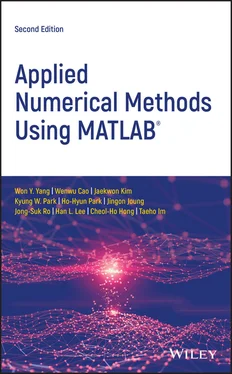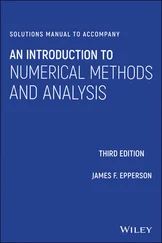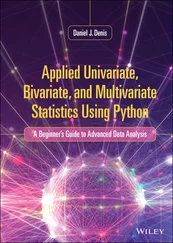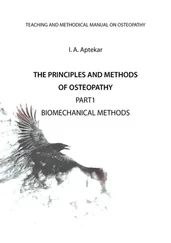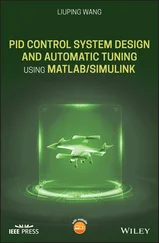1 Cover
2 Preface
3 Acknowledgments
4 About the Companion Website
5 1 MATLAB Usage and Computational Errors 1.1 Basic Operations of MATLAB 1.2 Computer Errors vs. Human Mistakes 1.3 Toward Good Program Problems
6 2 System of Linear Equations 2.1 Solution for a System of Linear Equations 2.2 Solving a System of Linear Equations 2.3 Inverse Matrix 2.4 Decomposition (Factorization) 2.5 Iterative Methods to Solve Equations Problems
7 3 Interpolation and Curve Fitting 3.1 Interpolation by Lagrange Polynomial 3.2 Interpolation by Newton Polynomial 3.3 Approximation by Chebyshev Polynomial 3.4 Pade Approximation by Rational Function 3.5 Interpolation by Cubic Spline 3.6 Hermite Interpolating Polynomial 3.7 Two‐Dimensional Interpolation 3.8 Curve Fitting 3.9 Fourier Transform
8 4 Nonlinear Equations 4.1 Iterative Method toward Fixed Point 4.2 Bisection Method 4.3 False Position or Regula Falsi Method 4.4 Newton(‐Raphson) Method 4.5 Secant Method 4.6 Newton Method for a System of Nonlinear Equations 4.7 Bairstow's Method for a Polynomial Equation 4.8 Symbolic Solution for Equations 4.9 Real‐World Problems
9 5 Numerical Differentiation/Integration 5.1 Difference Approximation for the First Derivative 5.2 Approximation Error of the First Derivative 5.3 Difference Approximation for Second and Higher Derivative 5.4 Interpolating Polynomial and Numerical Differential 5.5 Numerical Integration and Quadrature 5.6 Trapezoidal Method and Simpson Method 5.7 Recursive Rule and Romberg Integration 5.8 Adaptive Quadrature 5.9 Gauss Quadrature 5.10 Double Integral 5.11 Integration Involving PWL Function
10 6 Ordinary Differential Equations 6.1 Euler's Method 6.2 Heun's Method – Trapezoidal Method 6.3 Runge‐Kutta Method 6.4 Predictor‐Corrector Method 6.5 Vector Differential Equations 6.6 Boundary Value Problem (BVP) Problems
11 7 Optimization 7.1 Unconstrained Optimization 7.2 Constrained Optimization 7.3 MATLAB Built‐In Functions for Optimization 7.4 Neural Network[K‐1] 7.5 Adaptive Filter [Y‐3] 7.6 Recursive Least Square Estimation (RLSE) [Y‐3]
12 8 Matrices and Eigenvalues 8.1 Eigenvalues and Eigenvectors 8.2 Similarity Transformation and Diagonalization 8.3 Power Method 8.4 Jacobi Method 8.5 Gram‐Schmidt Orthonormalization and QR Decomposition 8.6 Physical Meaning of Eigenvalues/Eigenvectors 8.7 Differential Equations with Eigenvectors 8.8 DoA Estimation with Eigenvectors[Y-3]
13 9 Partial Differential Equations 9.1 Elliptic PDE 9.2 Parabolic PDE 9.3 Hyperbolic PDES 9.4 Finite Element Method (FEM) for Solving PDE 9.5 GUI of MATLAB for Solving PDES – PDEtool
14 Appendix A: Appendix AMean Value TheoremMean Value Theorem
15 Appendix B: Appendix BMatrix Operations/PropertiesMatrix Operations/Properties B.1 Addition and Subtraction B.2 Multiplication B.3 Determinant B.4 Eigenvalues and Eigenvectors of a Matrix1 B.5 Inverse Matrix B.6 Symmetric/Hermitian Matrix B.7 Orthogonal/Unitary Matrix B.8 Permutation Matrix B.9 Rank B.10 Row Space and Null Space B.11 Row Echelon Form B.12 Positive Definiteness B.13 Scalar (Dot) Product and Vector (Cross) Product B.14 Matrix Inversion Lemma
16 Appendix C: Appendix CDifferentiation W.R.T. A VectorDifferentiation W.R.T. A Vector
17 Appendix D: Appendix DLaplace TransformLaplace Transform
18 Appendix E: Appendix EFourier TransformFourier Transform
19 Appendix F: Appendix FUseful FormulasUseful Formulas
20 Appendix G: Appendix GSymbolic ComputationSymbolic Computation G.1 How to Declare Symbolic Variables and Handle Symbolic Expressions G.2 Calculus G.3 Linear Algebra G.4 Solving Algebraic Equations G.5 Solving Differential Equations
21 Appendix H: Appendix HSparse MatricesSparse Matrices
22 Appendix I: Appendix IMATLABMATLAB
23 References
24 Index
25 Index for MATLAB Functions
26 Index for Tables
27 End User License Agreement
1 Chapter 1 Table 1.1 Conversion type specifiers and special characters used in fprintf()... Table 1.2 Graphic line specifications used in the ‘ plot()’ command. Table 1.3 Functions and variables inside MATLAB. Table 1.4 Relational operators and logical operators. Table P1.4 The depth of the rock layer. Table P1.16 Results of operations with backslash( \) operator and ‘ pinv()’ c...
2 Chapter 2Table 2.1 Residual error and the number of floating‐point operations of vario...Table P2.2 Comparison of ‘ Gauss()’ with different pivoting methods in terms o...Table P2.3 Comparison of several methods for solving a set of linear equation...Table P2.4 The computational load of the methods to solve a tridiagonal syste...Table P2.6.1 Comparison of several methods for computing the LS solution.Table P2.6.2 Comparison of several methods for solving a system of linear equ...
3 Chapter 3Table 3.1 Divided difference table.Table 3.2 Divided differences.Table 3.3 Chebyshev coefficient polynomials.Table 3.4 Boundary conditions for a cubic spline.Table 3.5 Linearization of nonlinear functions by parameter/data transformati...Table P3.6 Bulirsch‐Stoer method for rational function interpolation.
4 Chapter 4Tabe P4.6 Comparison of various methods used for solving nonlinear equations.Table P4.8 Using ‘Newtons()’/‘fsolve()’ for systems of nonlinear equations.Table P4.9 Using ‘Newtons()’/‘fsolve()’ for systems of nonlinear equations.
5 Chapter 5Table 5.1.1 The forward difference approximation (5.1.4) for the first deriva...Table 5.1.2 The central difference approximation (5.1.8) for the first deriva...Table 5.2 The difference approximation formulas for the first and second deri...Table 5.3 Romberg table.Table P5.2 Three functions each given as a set of five data pairs.Table P5.4 Results of using various numerical integration methods.Table 5.7 Results of using various numerical integration methods for improper...Table P5.8 Results of using various numerical integration methods.Table P5.10 Relative error results of suing various numerical integration met...Table P5.12 Results of using various numerical integration methods for (P5.12...Table P5.15.1 Results of using ‘ int2s()’ and “ dblquad()' for the integral (...Table P5.15.2 Results of using ‘ int2s()’ and ‘ dblquad()’ for the integral (...Table P5.15.3 Results of using the double integration routine ‘ int2s()’ for (...
6 Chapter 6Table 6.1 A numerical solution of the DE (6.1.1) obtained by the Euler's meth...Table 6.2 Results of applying several functions for solving a simple DE.Table P6.11 Comparison of the BVP solvers ‘ bvp2_shoot()’ and ‘ bvp2_fdf()’....Table P6.12 Comparison of the BVP solvers ‘ bvp2_shoot()’ and ‘ bvp2_fdf()’....
7 Chapter 7Table 7.1 Results of using the several optimization functions with various in...Table 7.2 Results of using several unconstrained optimization functions with ...Table 7.3 The names of the MATLAB built‐in minimization functions.Table P7.2.1 Extrema (maxima/minima) and saddle points of the function (P7.2....Table P7.2.2 Points reached by the several optimization functions.Table P7.7 The results of using ‘ fmincon()’ with different initial guess.Table P7.8 The results of penalty methods depending on the initial guess and ...
8 Chapter 9Table P9.8.1 The maximum absolute error and the number of nodes.Table P9.8.2 The maximum absolute error and the number of nodes.Table P9.8.3 The maximum absolute error and the number of nodes.
9 4 Table D.1Laplace transforms of basic functions. Table D.2Properties of Laplace transform.
10 5 Table E.1Definition and properties of the CTFT (continuous‐time Fourier transfo... Table E.2Properties of DTFT (discrete‐time Fourier transform.)
Читать дальше
